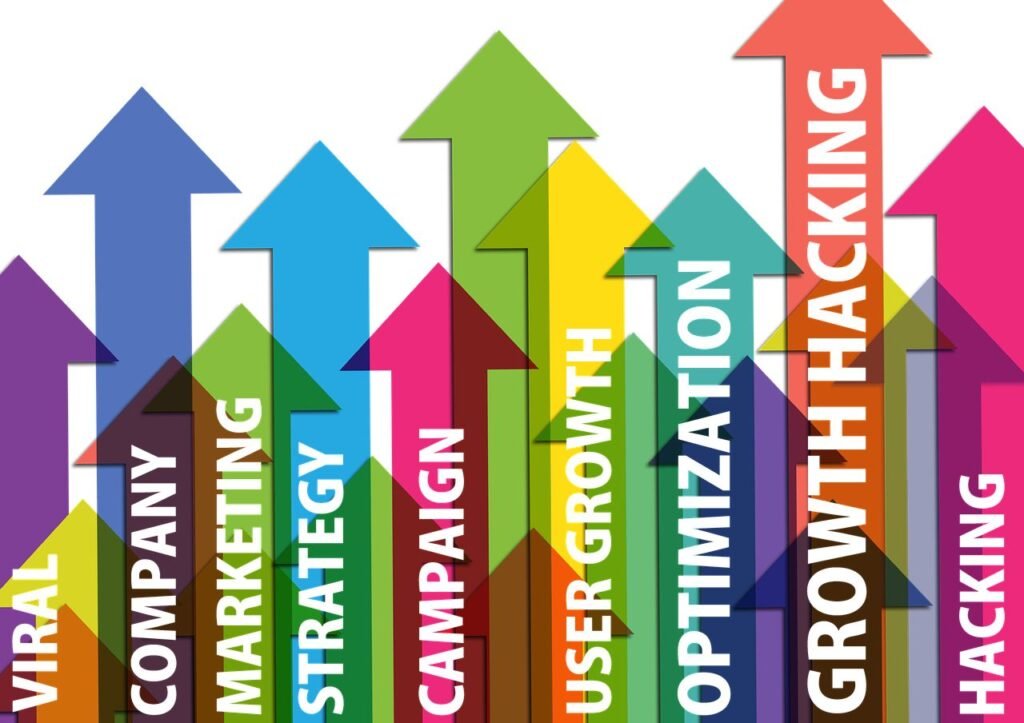Maximising Business Growth: Unleashing the Potential of Pay-Per-Click Advertising

Pay-per-click (PPC) advertising stands as a formidable digital marketing tool empowering businesses to engage their target audience and channel traffic to their online domains. Unlike conventional advertising avenues, PPC advertising delivers tangible outcomes, affording businesses control over their ad expenditure by only paying for actual clicks to their website. This renders PPC advertising a potent and cost-efficient solution for enterprises of all scales. By enabling targeted outreach encompassing specific keywords, geographic locations, and devices, PPC advertising furnishes businesses with the adaptability to fine-tune and optimize their marketing endeavors for optimal results. Whether the aim is to bolster visibility, attract precise traffic, or fortify online presence, PPC advertising emerges as a potent solution primed to drive business success. Crafting Targeted Traffic Targeted traffic epitomizes an audience predisposed to engage with a business’s products or services. PPC advertising emerges as a beacon for businesses seeking to tap into their ideal audience by honing in on specific keywords, geographical regions, and device preferences. This strategic approach ensures businesses reach potential customers during moments of active inquiry, thereby channeling high-quality, targeted traffic to their websites. By aligning marketing efforts with the right audience, PPC advertising empowers businesses to accomplish marketing objectives and optimize returns on investment. Elevating Visibility Heightened visibility constitutes a pivotal benefit inherent in PPC advertising. By securing prime placements atop search engine results pages for pertinent keywords, PPC advertising enhances the prospects of businesses being discovered by potential customers. This advertising mode extends businesses’ reach across multiple platforms, encompassing search engines, social media, and display networks. Augmented visibility serves to bolster brand awareness and amplify online presence, fostering increased traffic, conversions, and ultimately, revenue generation. By embracing PPC advertising, enterprises can broaden their audience reach, assert their brand authority, and fuel sustained growth trajectories. Measurable Outcomes Unlike conventional advertising paradigms, PPC advertising furnishes businesses with real-time tracking and measurement capabilities for their campaigns. This translates into actionable insights, enabling businesses to gauge the efficacy of their advertising endeavors and refine strategies accordingly. Armed with comprehensive performance data, businesses can discern successful keywords, ad formats, and targeting tactics, thereby optimizing campaigns for enhanced outcomes. Furthermore, PPC advertising empowers businesses to exercise precise control over their advertising budget, rendering it an economical avenue suitable for entities of all dimensions. By scrutinizing campaign performance, businesses can make well-informed decisions and continually enhance marketing efforts for maximum efficacy. Cost-Efficiency at Its Core In stark contrast to traditional advertising modalities, PPC advertising epitomizes financial prudence, affording businesses the latitude to set and regulate their advertising expenditure. With PPC advertising, businesses incur costs solely upon user interaction with their ads, endowing them with heightened command over their advertising outlay. Furthermore, PPC advertising facilitates audience targeting during opportune moments when consumer action is most likely, thereby enhancing return on investment. By embracing PPC advertising, businesses can streamline audience engagement efforts efficiently while adhering to predefined advertising budgets. Irrespective of budget size, PPC advertising offers cost-effective avenues capable of propelling businesses towards their marketing objectives and catalyzing growth. Flexibility in Action Flexibility emerges as another hallmark of PPC advertising, enabling businesses to adapt and fine-tune campaigns in real-time. This agility empowers businesses to swiftly respond to evolving market dynamics and consumer behaviors. By leveraging PPC advertising platforms, businesses gain access to a wealth of data and insights, facilitating informed decision-making and dynamic campaign optimization. With PPC advertising, businesses can effortlessly scale campaigns to meet evolving demands, underscoring its status as a flexible solution poised to evolve alongside business ventures. Precise Audience Engagement in Real-Time A chief advantage of PPC advertising lies in its ability to engage the target audience at opportune junctures. While traditional advertising methods adopt broad-reaching strategies, PPC advertising empowers businesses to target specific demographics, geographic regions, and consumer behaviors. This precision targeting ensures businesses intersect with potential customers during critical moments, heightening the likelihood of campaign success. For instance, local businesses retailing seasonal merchandise can target consumers in their vicinity searching for said products during peak seasons, optimizing ad visibility and enhancing the probability of customer conversion. By strategically timing audience engagement, PPC advertising empowers businesses to maximize advertising budgets and attain marketing objectives effectively. Whether the goal is to drive website traffic, generate leads, or boost sales, PPC advertising furnishes the means to reach the target audience and realize desired outcomes. Conclusion In summation, PPC advertising emerges as a formidable tool poised to confer numerous benefits upon businesses of all magnitudes. From targeted traffic and amplified visibility to measurable outcomes and cost-efficiency, PPC advertising presents a spectrum of advantages capable of steering businesses towards marketing success and sustained growth. With its innate flexibility and real-time campaign refinement capabilities, PPC advertising equips businesses with the tools to make informed decisions and pivot swiftly in response to evolving market conditions. Whether the objective is to drive sales, fortify brand awareness, or tap into new markets, PPC advertising serves as a catalyst for achieving goals and ushering prosperity to businesses.
Unlocking Your Online Potential: Mastering SEO Strategies

In today’s dynamic digital landscape, establishing a commanding online presence is non-negotiable for businesses aiming to connect with their target audience. An indispensable tool in this pursuit is Search Engine Optimization (SEO), pivotal for enhancing a website’s visibility and expanding its reach. By optimizing various elements on a website, including content and technical features, businesses can elevate their rankings on search engine results pages (SERPs), leading to heightened website traffic, increased brand exposure, and ultimately, broader online outreach. This article delves into a comprehensive exploration of essential SEO techniques to empower websites to maximize their online potential and drive substantial traffic. Unveiling the Power of Keywords At the core of effective SEO lies keyword research—a fundamental process that underpins strategic success. The initial step involves pinpointing the target audience, necessitating a deep understanding of their preferences, interests, and search habits. Subsequently, the focus shifts to uncovering relevant keywords commonly utilized in their search queries. Employing tools like Google Keyword Planner facilitates the identification of keywords boasting high search volumes and low competition. Integrating these keywords into the website’s content, meta tags, and other elements optimizes the site for search engines, enhancing its discoverability. Optimizing On-Page Elements On-page optimization serves as a cornerstone for refining individual web pages to bolster their rankings on search engines and attract pertinent traffic. This involves fine-tuning various on-page components such as meta tags, content, and HTML source code to render them more search engine-friendly. Elevating Content Quality The creation of high-quality, relevant, and informative content is paramount for on-page optimization. Content should not merely cater to target keywords but also prioritize user experience—a crucial criterion in search engine algorithms. Crafting Compelling Meta Descriptions and Title Tags Meta descriptions and title tags offer succinct summaries and titles of web pages, respectively, displayed in SERPs. Optimization of these elements for target keywords, coupled with compelling copywriting, entices users to click through to the site, driving traffic. Structuring URLs for Success Well-structured URLs not only facilitate seamless website navigation for users but also aid search engines in comprehending the site’s content hierarchy. Concise, descriptive URLs incorporating targeted keywords enhance search engine visibility. Harnessing the Power of Header Tags Header tags (H1, H2, H3, etc.) play a pivotal role in content structuring, aiding search engines in discerning content hierarchy. Appropriately utilizing header tags enhances content accessibility for both users and search engines. Optimizing Images for Impact Image optimization is a critical facet of on-page optimization. Optimizing image size, file format, and incorporating descriptive alt text substantially augments website visibility on search engines. Off-page Optimization Strategies Off-page optimization entails optimizing external factors that influence a website’s search engine ranking. Below are key strategies to amplify off-page SEO effectiveness. Building Backlinks Strategically Link building involves acquiring backlinks from other websites, bolstering a website’s authority and credibility while driving referral traffic. Cultivating a Vibrant Social Media Presence Establishing a robust presence across social media platforms amplifies a website’s online outreach. Regular posting, engagement with followers, and content sharing amplify online visibility and drive traffic to the site. Technical SEO Essentials Technical SEO encompasses optimizing a website’s technical aspects to enhance its visibility and ranking on SERPs. Vital components of technical SEO include: Ensuring Swift Site Speed Site speed is pivotal for optimal user experience and significantly impacts search engine ranking. Optimizing image and file sizes, utilizing reliable hosting services, and minimizing code and plugins enhance site speed. Embracing Mobile-friendliness With a surge in mobile internet usage, mobile-friendliness is imperative for websites. Responsive design, large font sizes, and easy-to-click buttons optimize the mobile viewing experience and secure favorable search engine rankings. Leveraging Sitemaps and Robots.txt Sitemaps and robots.txt files play pivotal roles in technical SEO, aiding search engines in crawling and indexing website content efficiently. Measuring and Tracking Success Measuring and tracking results are integral to gauging the efficacy of SEO strategies. Leveraging tools like Google Analytics empowers website owners to analyze traffic, identify areas for improvement, and track progress over time. Setting Realistic Goals Setting measurable goals pertaining to website performance facilitates progress tracking and informed decision-making, focusing on metrics like traffic, rankings, and bounce rates. Regular Progress Monitoring Regular monitoring of progress towards SEO goals is crucial for making data-driven decisions and identifying areas for optimization. In conclusion, unlocking a website’s online potential through effective SEO strategies demands a holistic and strategic approach. By integrating elements such as keyword research, on-page and off-page optimization, technical SEO, and rigorous performance tracking, websites can ascend to higher rankings, garner increased traffic, and realize their fullest online potential amidst the ever-evolving digital landscape.
Mastering the Top 10 Digital Skills for 2024: Your Path to Employability

As digital technology continues to advance at a rapid pace, proficiency in digital skills has become indispensable for both personal growth and professional success. In today’s digital-centric job market, employers highly value individuals with a diverse set of digital competencies. In this comprehensive guide, we will delve into the top 10 digital skills that are poised to significantly boost your employability in 2024. Strategic Social Media Mastery: Social media platforms have evolved into powerful tools for businesses to connect with their audience and foster brand growth. This skill entails leveraging various social media platforms to engage audiences, enhance brand visibility, drive traffic, and convert leads into loyal customers. Elevating Website Visibility through SEM: In an era dominated by search engines, understanding Search Engine Marketing (SEM) is paramount. This skill revolves around utilizing paid advertising strategies to bolster website visibility, attract relevant traffic, and enhance conversion rates. Data Analytics Proficiency: Proficiency in data analytics is indispensable for making informed business decisions in today’s data-driven landscape. This skill involves harnessing data analytics tools to extract insights, identify trends, and formulate data-driven strategies. Crafting Compelling Content for Content Marketing: Content marketing hinges on the creation of valuable and engaging content to attract target audiences. This skill encompasses crafting optimized content, conducting keyword research, and utilizing diverse channels to distribute and promote content effectively. Effective Email Marketing Strategies: Email marketing remains a cornerstone of digital marketing, facilitating lead nurturing and customer relationship management. This skill focuses on designing and executing email campaigns that engage audiences, nurture leads, and drive conversions. Optimising Mobile User Experience: With the prevalence of mobile devices, optimising user experience on mobile platforms is imperative. This skill involves understanding mobile marketing strategies, responsive design principles, and app development trends to engage mobile users effectively. Strategic Campaign Development: Strategic planning is crucial for developing comprehensive digital marketing campaigns. This skill encompasses setting clear objectives, identifying target audiences, leveraging data analytics, and continually optimizing campaigns for optimal performance. Social Selling Techniques: Social selling leverages social media channels to identify, connect with, and influence potential customers. This skill emphasizes building relationships, nurturing leads, and driving sales through personalized social media interactions. Maximizing Performance with PPC Marketing: PPC marketing enables businesses to drive targeted traffic and achieve measurable results through paid advertising campaigns. This skill focuses on running effective PPC campaigns, conducting keyword research, and optimizing landing pages for maximum impact. Harnessing Video for Content Marketing: Video content has emerged as a potent tool for engaging audiences and driving brand awareness. This skill involves understanding video production techniques, storytelling, and leveraging platforms to effectively distribute video content. Conclusion: In an ever-evolving digital landscape, mastering these 10 essential digital skills will undoubtedly enhance your employability in 2024. Whether it’s strategic social media engagement or leveraging video content for marketing purposes, each skill plays a pivotal role in shaping a successful career in digital marketing. By embracing these skills and staying abreast of industry trends, individuals can position themselves as indispensable assets in the digital job market of the future.
7 Essential Social Media Tools for Content Creation

Effective content creation for social media requires the right tools. Luckily, there are numerous social media tools available, including AI-powered options, that can make your content creation journey easier. In a recent LinkedIn poll, 86% of marketers reported using ChatGPT as their preferred AI tool for content marketing. In this article, we will explore the most popular and effective tools that can enhance your content creation for social media. Buffer: A popular tool for scheduling and managing social media content, with an AI assistant for content creation. Conclusion: These 27 essential social media tools will greatly enhance your content creation efforts. Whether you need assistance with image and graphic creation, video editing, audio content, community building, research and SEO, scheduling and management, copywriting and editing, or social media listening, these tools will prove invaluable. Take your content creation to the next level by utilizing these powerful and effective resources.

